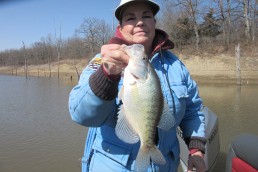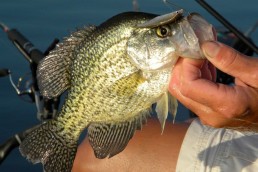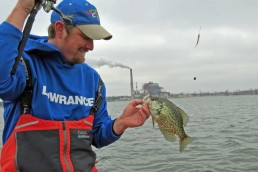Lake Shelbyville: Cold-Weather Crappies
SHARE THIS POST
I’m not sure that, when this article comes out, if the lake will be open or frozen. But as I’m writing this, the lake is still open and crappies are being caught. The lake level is still just above summer pool. Maybe it’ll be a year in which it doesn’t freeze. It has had ice on it in some of the coves and protected areas, but I think right now, it’s just about all open of course, that could change quickly with a little colder weather.
I used to say, about any year the lake froze, it usually thawed out around the middle of February. But now, it seems the seasons have shifted a little, and our winters are a little later. For example, last year, the lake froze late and didn’t open back up until the first week of March. We’ll have to wait and see what this year brings.
If we have open water in February, local anglers will be out. It used to be, during winter, when we went out, it was rare to see another boat. Nowadays, with better winter clothing, and thanks to social media spreading the word if they’re biting, you go out on a decent day and you can’t believe how many boats are out.
If you start catching fish and a couple of boats go by and see you catch some, before you know it, you’ve got boats all around you. I don’t like a crowd, so it’s then time to go somewhere else. You used to never have that problem this time of year.
The good thing is, this time of year, it’s still peaceful out there: No big boats flying by throwing a big wake, no jet skis buzzing by and no bugs. It’s a good time for fishing and catching.
This time of year, we frequently find crappies suspended around cover like standing timber in deep water. They may be in 20 to 25 feet of water, suspended anywhere from 5 to 15 feet deep. You have to try different depths until you find where they are. Sometimes, by watching your locator, you can tell where most seem to be holding, and it gives you a place to start.
Are you enjoying this post?
You can be among the first to get the latest info on where to go, what to use and how to use it!
We sometimes use a bobber to control the depth of the bait when they’re suspended like this. We prefer to use a stationary bobber, rather than a slip bobber, because we’re usually moving the bobber by twitching our rod tips. This gives the bait a little movement as we gradually work it back to the boat. If you’re using a slip bobber and you’re moving your rod tip or reeling, the line slips through the bobber, and the bait can end up right below the bobber instead of holding at the depth you set it.
A fixed bobber is harder to cast than a slip bobber, but it just works better. You’re really never sure what depth your bait’s at with a slip bobber; the wind blowing your line pulls your bait up towards the bobber, and each time you reel or just try to twitch the bobber, it changes the depth of the bait.
If they’re deeper than say, 10 feet or so, then you can usually just vertically jig without a bobber.
Somedays, instead of being suspended over deep water, they may be around cover in water less than 5 feet deep. If it’s brushy cover, we just tightline, casting without a bobber and working baits around the cover. If they’re around stumps, again the bobber works well, casting past the stump, then working the bobber/bait back up to the stump. Using the bobber lets you work the bait slowly around the cover, giving the fish more reaction time to hit the bait.
As always, just try different areas, types of cover and depths until you find them. Then don’t get on Facebook and post where they are! MWO
MWO
SHARE THIS POST
Did you enjoy this post?
You can be among the first to get the latest info on where to go, what to use and how to use it!
Mary Satterfield
Lifelong angler Mary Satterfield is a retired professional bass angler, and has she held titles of National and World Champions and Angler of the Year. She’s run the multispecies Eagle Creek Guide Service on Lake Shelbyville since 1989. She may be contacted at: 217-756-3299.



